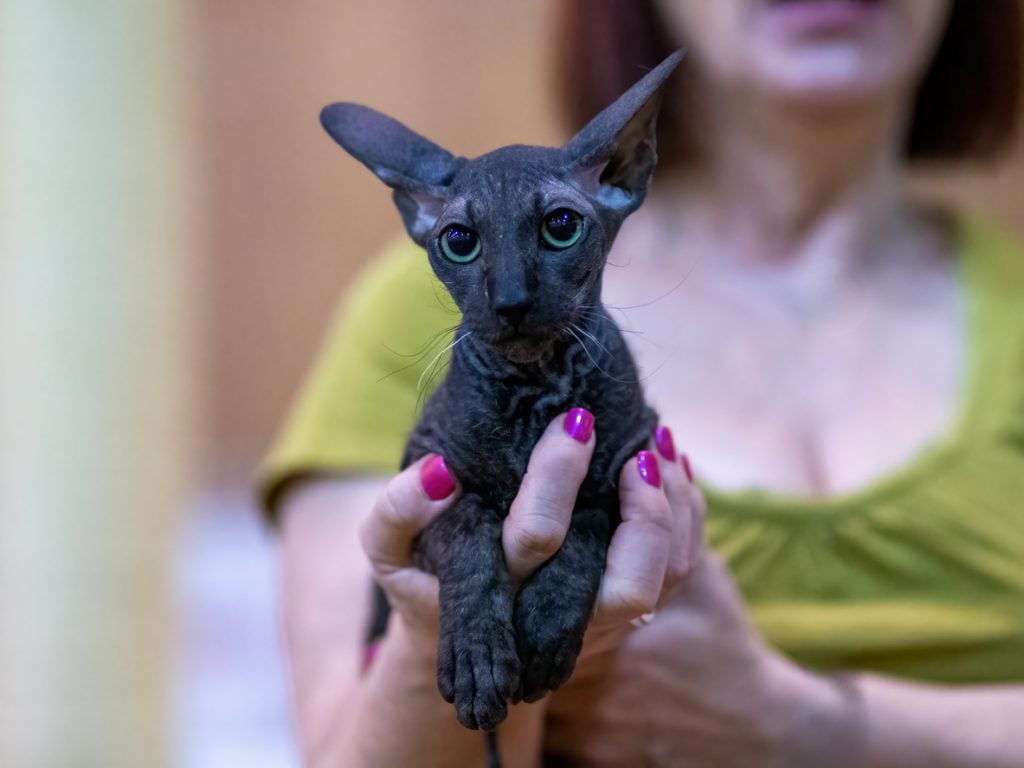If you love cats, having an allergy to them can be a devastating blow. Unfortunately, this is a pretty common scenario.
You’ve probably heard of hypoallergenic cats: breeds that aren’t supposed to trigger allergies. But the truth is that there isn’t a completely hypoallergenic cat breed in the UK or anywhere else.
That means cat owners with allergies need to understand what triggers their allergies and the steps they can take to reduce their symptoms. The good news is there are many options, from choosing a less allergenic breed to minimising allergies in the home. Even using special cat food can help neutralise the allergens that make us sneeze in the first place.
Understanding Cat Allergies
It’s easy to assume that cat hair triggers an allergic reaction, but this isn’t the case.
Most cat allergies are down to “primary cat allergen Fel d 1,” explained vet surgeon Dr. Alex Crow. This allergen is produced in the sebaceous, salivary, and anal glands, so it ends up anywhere and everywhere your cat has been.
Research shows 96% of cat allergies are due to Fel d 1. However, people can also have allergies to eight other cat allergens, including Fel d 4, an allergen found in cat urine and saliva.
If someone has a cat allergy, their immune system produces an immunoglobulin when exposed to these allergens. Allergy UK estimates that around 35% of pet owners in the UK have some sort of allergy. Cat allergies are more common in people who have asthma, eczema, or other allergies like hay fever.
Some typical symptoms of cat allergies include:
- Sneezing
- Itchy eyes and nose
- Red eyes
- Runny nose
- Blocked nose
- Cough
- Mucus in the nose and throat
Cat allergies can also cause more serious symptoms, for example:
- Rhinitis
- Asthma
- Bronchospasm (in asthmatics)
Defining Hypoallergenic Cats
Do hypoallergenic cats really exist? Unfortunately for allergy sufferers — the answer is no.
“No cat can truly be considered hypoallergenic,” vet Dr. Daisy May explained. That’s because they all produce allergens. However, some cats do produce fewer allergens than others. It’s not entirely clear why this is, but research shows that:
- Entire male cats produce the most Fel d 1.
- Female cats produce less Fel d 1 than males.
- Coat colour and hair length don’t impact allergen production.
- Allergen production may decline as a cat ages.
Popular Hypoallergenic Cat Breeds
We’ve already discovered that there’s no such thing as a truly hypoallergenic cat, but “some breeds seem to produce fewer allergens and are less likely to cause reactions,” explained Dr. May.
These breeds include:
- Russian Blue
- Bengal
- Sphynx
- Siberian
- Cornish Rex
- LaPerm
- Javanese
- Devon Rex
- Balinese
- Oriental Shorthair
Read our full article to learn more about these more hypoallergenic cat breeds.
It’s thought that these breeds produce fewer allergens because they shed less fur and produce less dander.
Dr. Crow said that while these breeds “tend to produce less of the primary cat allergen Fel d 1, individual variation still exists.” That means symptoms can differ from person to person, even with these less allergenic breeds.
It also means when choosing a new cat, it’s best to arrange for a test meeting, if possible. “Spending quality time with different breeds is invaluable for discerning one’s own sensitivity levels,” said Dr May.
Knowing that all cats produce some allergens doesn’t make it impossible to share your home with a cat. However, it does mean you’ll need to choose a cat that seems to trigger your allergies the least. You’ll also need to consider how to minimise any allergens within your home.

Sue Thatcher via iStock
Tips for Living with Hypoallergenic Cats
People with allergies can live comfortably alongside their cats — it just needs a bit of careful planning. These four tips can help.
1. Maintain good hygiene practices
You know how glitter gets absolutely everywhere? Well, cat allergens are pretty similar, which means allergen control requires an integrated approach.
“While many focus on the cat’s contribution, environmental mitigation is equally critical for a comfortable home,” explained Dr. Crow.
Recommended steps for reducing allergens within your home include:
- Using a high-efficiency particulate air (HEPA) filter to remove airborne allergens
- Regularly vacuuming and steam cleaning carpets and soft furnishings
- Using a vacuum with a HEPA filter
- Choosing hard floors (like tiles or wood) over carpet, where possible
- Washing your hands after stroking your cat or handling things they’ve been in contact with
- Restricting your cat’s access to your bedroom (sorry!)
- Opening windows for ventilation where possible
- Washing your cat’s bed regularly, using a hot wash
- Wiping down walls and hard floors regularly
- Keeping your cat’s litter tray somewhere out of the way
- Using gloves and a mask when cleaning out your cat’s litter tray
2. Stick to a regular grooming routine
As well as maintaining good hygiene within the home, a regular grooming routine helps reduce the amount of fur and dander that your cat sheds. If possible, grooming should be carried out by someone without allergies. Ideally, your cat should also be groomed outside so the allergens don’t collect within your home.
Bathing can also reduce allergies, although it should happen weekly to be effective. Some cats may not be too keen on this, so wiping your cat’s coat with a baby wipe is a good alternative.
3. Consider allergy-reducing cat food
Purina has developed a cat food to neutralise Fel d 1 so your cat produces fewer allergens. It can take up to three weeks to take effect. However, if used consistently, this food can help reduce allergic reactions in pet parents.
This is different to hypoallergenic cat food, which is designed for cats with allergies to specific foods like beef or fish.
4. Work with a professional
Last but not least, people with allergies should work with either their GP or a professional allergy specialist.
Immunotherapy and other medications like antihistamines and decongestants can help relieve allergy symptoms, but should always be discussed with your doctor. “Symptom management often demands a personalized plan,” explained Dr. Crow. “What works for one may not suit another, so keeping lines of communication open with an allergist optimises strategies.”



